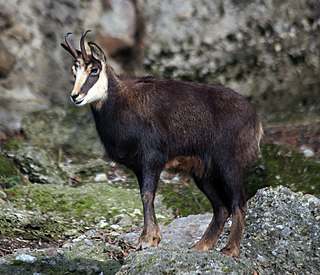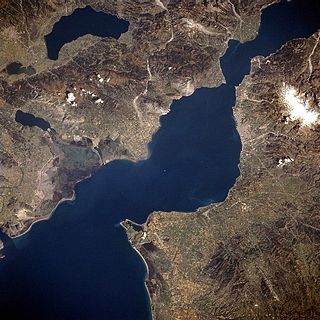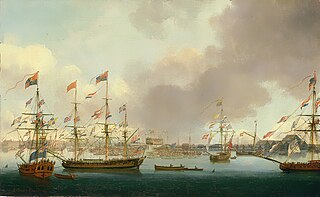Two ships of the Royal Navy have been named HMS Chamois after the mountain goat of the same name:

The Royal Navy (RN) is the United Kingdom's naval warfare force. Although warships were used by the English kings from the early medieval period, the first major maritime engagements were fought in the Hundred Years War against the Kingdom of France. The modern Royal Navy traces its origins to the early 16th century; the oldest of the UK's armed services, it is known as the Senior Service.

The chamois is a species of goat-antelope native to mountains in Europe, including the European Alps, the Pyrenees, the Carpathians, the Tatra Mountains, the Balkans, the Rila - Rhodope massif, parts of Turkey, the Caucasus, and the Apennines. The chamois has also been introduced to the South Island of New Zealand. Some subspecies of chamois are strictly protected in the EU under the European Habitats Directive.
- HMS Chamois (1896) was a Palmer three funnel, 30 knot destroyer launched in 1896 and lost in the Gulf of Patras in 1904 when she foundered after her own broken propeller blade pierced her hull.
- HMS Chamois (J28) was a Lend-Lease Catherine-class minesweeper launched in 1942 and damaged by a mine in 1944. She was returned to the US Navy in 1946 and broken up in 1950.

HMS Chamois was a Palmer three-funnel, 30-knot destroyer ordered by the Royal Navy under the 1895–1896 Naval Estimates. She was the first ship of the Royal Navy to carry this name. She was commissioned in 1897 and served in both the Channel and the Mediterranean. She foundered in 1904 after her own propeller pierced her hull.

The C class as designated in 1913 was a heterogeneous group of torpedo boat destroyers (TBDs) built for the Royal Navy in the late-1890s. They were constructed to the individual designs of their builders to meet Admiralty specifications. The uniting feature of the class was a top speed of 30 knots, a "turtleback" forecastle and that they all had three funnels. The funnels were spaced equidistantly and were of equal height, but the central one was thicker.

The Gulf of Patras is a branch of the Ionian Sea in Western Greece. On the east, it is closed by the Strait of Rion between capes Rio and Antirrio, near the Rio-Antirrio bridge, that is the entrance of the Gulf of Corinth. On the west, it is bounded by a line from Oxeia island to Cape Araxos. To the north it is bounded by the shore of Aetolia-Acarnania in continental Greece, and to the south by Achaea in the Peloponnese peninsula. It is 40–50 km long, 10–20 km wide, and has an area of 350–400 km2.


